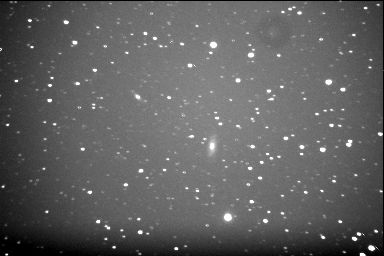SN2001cz in NGC4679 ( 12h 47mn30.23ss -39°34'16.7" )
CTIO Nick Suntzef
offset 0.6" W 31.4" S magnitude 14.7
http://www.ctio.noao.edu/~nick/sn/sn2001cz/sn2001cz.htm
Telescope LX200 12" f/d 2.7 ST7E
UAI173 Ste Clotilde REUNION ISLAND
CTIO Pablo Candia
http://ctios6.ctio.noao.edu/~candia/tabla/sn2001cz/tab1_01cz.html
 discovery image discovery image
2001/07/04.64 unflated binning 2x 60s |

reference image
2001/03/21.93 unflated limiting mag
19
binning 2x 60s |
 reference image reference image
2001/05/21.76 unflated limiting mag
19
binning 2x 60s |

reference image
2000/03/10.90 unflated limiting mag
19 180s |

confirmation image 2001/07/05.61 mag 14.7 180s
|

referenced image DSS UK Schmidt 1982/05/16.47
limiting mag 21
|
| |
|
SUPERNOVA 2001cz IN NGC 4679
R. Chassagne, Ste. Clotilde, Ile de Reunion, reports
the
discovery of an apparent supernova (mag about 14.7) on unfiltered
CCD images taken on July 4.64 and 5.61 UT with a 0.30-m reflector.
SN 2001cz is located at R.A. = 12h47m30s.17, Decl. = -39o34'48".1
(equinox 2000.0), which is 0".6 west and 31".4 south of the nucleus
of NGC 4679. Images taken on 2000 Mar. 10.9, and on 2001 Mar. 21.9
and May 21.7, show nothing at this position (limiting mag about
19.0), and SN 2001cz does not appear on a Digital Sky Survey (U.K.
Schmidt) image taken on 1982 May 16.47 (limiting mag about 21.0).
Dear SN watchers,
R. Chassagne has discovered his 9th SN 2001cz at mag 14.7. The host
galaxy NGC 4679 is a member of the famous Centaurus Cluster, and
probably near maximum. Congratulations, Robin!
IAUC 7657 informed that the discovery was made on July 4.64. The
position of the new object is: R.A. = 12h47m30s.17, Decl. =
-39o34'48".1 (2000.0), which is about 1" west and 32" south of
the
nucleus of the tilted spiral (SA(s)bc) galaxy NGC 4679. It is on the
southern bright arm.
Because of somewhat low galactic latitude (b = 23o.3), there are
plenty of foreground stars. Especially, a mag 15: star is
superimposed on the southern edge of the bulge region, which is about
10" due south of the nucleus of NGC 4679. Don't confuse it as a SN.
NGC 4679 is one of the brighest member of the Centaurus Cluster =
ACO 3526. This cluster has a large velocity dispersion, which is
probably due to the ongoing dynamical phenomena such as cluster
merging. The recession velocity of the cluster as a total is about
3400 km/s, which indicate that the expected maximum of typical SN Ia
is around mag 15.0. The previous SNe reported in this cluster ( < 5
degree from the center) are: SN 1990I in NGC 4650A (mv = 15.6, type Ia
some weeks after maximum, IAUC 5003); SN 1983A in MCG -06-28-022 (mpg
= 17.5, type unknown, IAUC 3764); and SN 1984I in MCG -07-27-049 (mv =
15.5, type I, IAUC 3944, 3946).
Sincerely Yours,
Hitoshi Yamaoka, Kyushu Univ., Japan
yamaoka@rc.kyushu-u.ac.jp
SUPERNOVA 2001cz IN NGC 4679
A. Pastorello, G. Altavilla, S. Benetti, E. Cappellaro,
and M.
Turatto, Osservatorio Astronomico di Padova, report: "A fully
reduced CCD spectrum (range 310.0-910.0 nm, resolution 1.0 nm),
obtained on July 12.01 UT with the Danish 1.54-m telescope (+
DFOSC), shows SN 2001cz (cf. IAUC 7657) to be a type-Ia supernova
at maximum light (+/- 2 days). The spectrum consists of a blue
continuum with superimposed P-Cyg lines of Ca II (H and K), S II,
and Si II ions. The expansion velocity deduced from minimum of the
Si II 635.5-nm doublet is 10 300 km/s (a recession velocity for the
parent galaxy of 4612 km/s was obtained from NED). Moreover, the
spectrum shows deep interstellar Na I D Galactic (equivalent width
about 0.04 nm) and extragalactic (EW about 0.11 nm) absorptions."
 discovery image
discovery image
